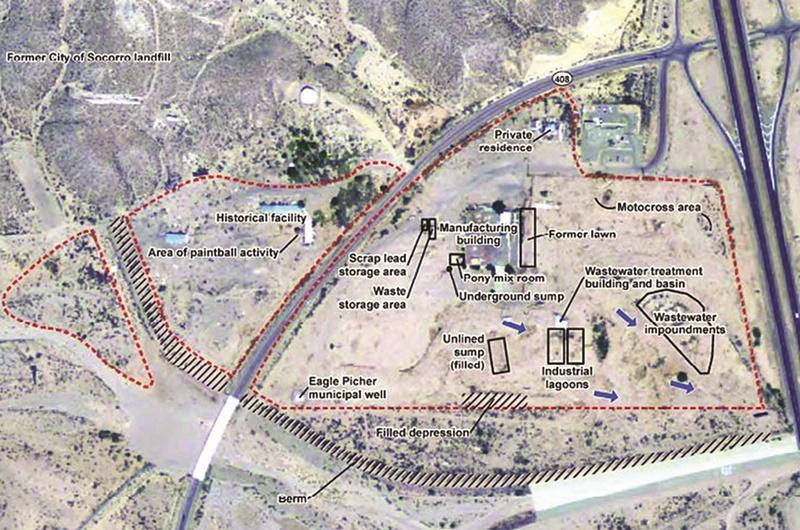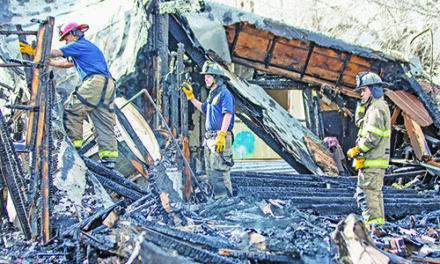
Plans to clean up the Eagle Picher site include removal of hazardous materials to an approved recycling center.
Courtesy Photo
The long-awaited cleanup of the property surrounding the Eagle Picher superfund site is slated to begin this summer, possibly as early as next month. That’s the word from Matthew Maez of the New Mexico Environmental Department, who said the contractor received authorization to begin preparing for cleanup activities earlier this month.
“This work will be performed directly under NMED management in consultation with and under the oversight of the EPA,” he said. “Aside from overseeing the work, NMED ensures the work is performed correctly from scientific and technical aspects. We also review the data to ensure cleanup progresses correctly.”
He said NMED has worked closely with the EPA to prepare the site for remedial activities.
“On-site cleanup activity is anticipated to begin in July or August,” Maez said.
Maez said previous site investigations identified four areas of lead-impacted soils at the former Eagle Picher facility above the lead cleanup goal of 800 milligrams per kilogram.
“These four areas correspond to the former locations of a battery plate stockpile, a material processing space, a wastewater impoundment, and one other isolated area with lead-contaminated soil,” he said. “Soils from these four areas total approximately 1,100 cubic yards and will be removed.”
Demolished and abating in-place asbestos-containing building material and lead-based paint from former facility structures will also be removed from the site.
“Removing the on-site soils and building materials, and completing other abatement work, is expected to take seven months,” Maez said. “Lead-impacted soils, asbestos-containing building material, and lead-based paint remnants that have been excavated or abated will be delivered to an approved hazardous waste-receiving landfill.”
He said any lead battery plates remaining on the property would be collected and transported to a recycling facility.
In the meantime, the EPA and NMED are in the final stages of additional investigation work on the toxic underground plume to ensure that the optimal groundwater remedial system will be implemented at the site.
“We anticipate building the first infrastructure components of the groundwater system in early 2024,” Maez said. “The groundwater remedy involves the installation of extraction wells throughout the length of the plume, transportation of the extracted groundwater through underground piping to a central treatment building, and treatment of the groundwater through advanced oxidation process technology. This technology uses ozone and hydrogen peroxide to destroy the organic compounds we’re concerned about in the groundwater plume.”
Sairam Appaji, EPA Remedial Project Manager, said plans are being finalized on handling the treated clean water.
“Once the contaminates in the water are removed, one option is to inject it back into the aquifer directly,” Appaji said. “The alternative is to pump the clean water into a holding pond so it could seep back into the ground.”
He said that injecting it back into the ground was part of the original design, but that would entail more logistics and expense. The alternative of transferring the water to the holding pond at the corner of Lopezville Road and Newberry Road is preferable at this point, he said.
Besides groundwater contamination, danger also comes from harmful gases rising from the plume, seeping up through the soil and water table.
Maez said performance monitoring will be conducted throughout the active treatment period and active containment of vapor instruction.
“This involves installing an active containment system of the soil gases,” Maez said. “The containment considers building construction sub-slab depressurization; homes constructed directly on foundations or crawl space depressurization and for dwellings using pier and beam (open space beneath) construction.
“Either method will be used to actively remove soil gas before it migrates indoors,” he said
Vickey Kelsey, a co-chair of the Eagle Picher Carefree Battery Superfund Community Advisory Group, which has played a significant role in following the progress of the project and communicating concerns and questions to the EPA and NMED, encourages community members to attend the next meeting.
“The CAG holds meetings on the second Thursday of every month where the public can get up-to-date information about these cleanup processes with EPA, the NMED, contractors, and others involved in the site cleanup,” she said. “It’s a public forum in which all affected and interested parties in Socorro can have a voice and actively participate in the cleanup processes.”
The next CAG meeting is at 6:30 p.m. on Thursday, June 8, at the Socorro Public Library.
“We just want to get as much information to the community and as much information from the community, which is the whole purpose of the CAG,” Kelsey said. “We have a lot of resources in the community, and I just want to make sure that they’re utilized, involved, and that this money doesn’t get used up in these routine blue tape, red tape kind of processes, and be used more efficiently. Because this community can handle it.”
Attend the Meeting
Go to EPA’s Eagle Picher Carefree Battery Superfund Site website at https://www.epa.gov/superfund/eagle-picher-carefree-battery and click on the link that says “Click here to join the meeting.”
Call 844-608-7693 and use the conference ID: 491 147 72#
Attend the meeting in person on the second floor of the Socorro Public Library.



















